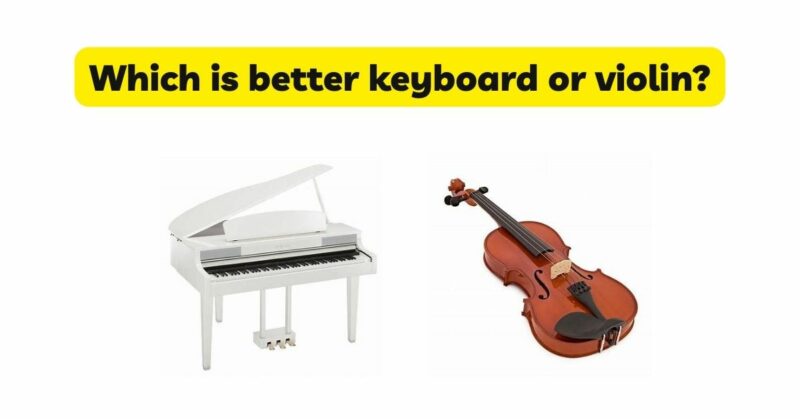When it comes to selecting a musical instrument, the keyboard and the violin are both popular choices that offer unique experiences and musical possibilities. Deciding which instrument is “better” depends on various factors, including personal preferences, musical goals, and individual aptitudes. In this article, we will delve into the qualities of the keyboard and the violin, examining their distinct features, technical demands, expressive capabilities, and versatility. By understanding the merits of each instrument, you can make an informed decision that aligns with your musical aspirations and brings you joy on your musical journey.
- Instrumental Characteristics and Expressiveness: The keyboard and the violin possess distinct instrumental characteristics and expressive qualities. The keyboard, whether it be an acoustic piano or an electronic keyboard, offers a wide range of notes, allowing for the creation of harmonies, melodies, and intricate musical arrangements. The piano’s versatility in producing a vast array of tones and dynamics makes it suitable for various musical genres. On the other hand, the violin is renowned for its ability to mimic the human voice and produce expressive, lyrical tones. Its distinct timbre and emotive qualities make it well-suited for conveying emotions and capturing the nuances of musical phrasing.
- Technical Demands and Learning Curve: Both instruments present unique technical demands and learning curves. The keyboard requires finger independence, hand coordination, and an understanding of music theory and notation. Mastering techniques such as proper hand placement, finger agility, and pedal control may take time and practice. The violin, on the other hand, requires precise finger placement, bow control, and intonation. Developing a strong sense of pitch and bowing techniques can be challenging, and progress may require dedicated guidance and regular practice. Consider your willingness to navigate the technical demands and the learning curve associated with each instrument.
- Versatility and Musical Repertoire: The keyboard and the violin offer different levels of versatility in terms of musical genres and repertoire. The keyboard, particularly the piano, has a vast repertoire that spans classical, jazz, pop, and contemporary styles. Its ability to play harmonies, melodies, and bass lines simultaneously provides ample opportunities for musical exploration and versatility. In contrast, the violin has a rich heritage in classical music, with a substantial repertoire of solo, chamber, and orchestral works. While the violin is primarily associated with classical music, it can also be adapted to other genres such as folk, jazz, and contemporary music. Consider the range of musical genres and repertoire that align with your musical interests and goals.
- Solo and Collaborative Opportunities: Both the keyboard and the violin offer opportunities for solo and collaborative performances. The keyboard’s harmonic capabilities and versatility make it suitable for solo performances, accompaniment, and ensemble playing. Its ability to provide harmonic support and play complex arrangements makes it well-suited for collaborations with other musicians. Similarly, the violin allows for solo performances, chamber music, and orchestral playing. Its expressive qualities and melodic nature make it a captivating instrument in both solo and collaborative contexts. Consider whether you prefer solo performances, collaborative opportunities, or a balance of both, as it can influence your decision.
- Instrumental Cost and Accessibility: Cost and accessibility are practical considerations to keep in mind when choosing an instrument. Keyboards, especially electronic keyboards, can be relatively more accessible in terms of cost and availability. Acoustic pianos, on the other hand, can be more expensive and require regular maintenance. Violins vary in price depending on the quality and craftsmanship, and the cost may include additional expenses such as bow, case, and ongoing maintenance. Furthermore, consider the availability of qualified instructors and learning resources for each instrument in your area.
- Personal Preference and Musical Affinity: Ultimately, personal preference and musical affinity play a significant role in determining which instrument is better suited to you. Consider the sounds and musical experiences that resonate with you the most. Reflect on the genres, styles, and artists that inspire you. Examine your emotional connection to each instrument and your desire to express yourself through their unique qualities. Choosing an instrument that aligns with your personal preferences and musical aspirations is essential for fostering joy and passion in your musical journey.
Conclusion: Labeling the keyboard or the violin as “better” oversimplifies the intricate qualities and artistic possibilities each instrument offers. The keyboard’s versatility, harmonic capabilities, and vast repertoire make it suitable for various genres and collaborative opportunities. In contrast, the violin’s expressive qualities, lyrical nature, and rich classical heritage offer a unique and emotionally captivating musical experience. The choice between the keyboard and the violin depends on personal preferences, musical goals, technical demands, and individual aptitudes. Consider the instrument’s characteristics, the expressive qualities that resonate with you, the learning curve, versatility, solo and collaborative opportunities, cost, and accessibility. Embrace the instrument that speaks to your heart and kindles your passion for music. Remember that the joy and fulfillment derived from playing an instrument come from the personal connection and the musical exploration it offers.


